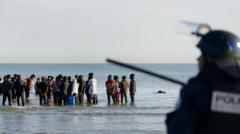Is Russia Enhancing Its Nuclear Sites Near the UK?

Russia’s Nuclear Modernization: A Closer Look at Military Developments Near Britain
In recent months, heightened tensions between Russia and the West have sparked concerns about the modernization of nuclear storage facilities in close proximity to Britain. New satellite imagery has revealed significant upgrades to key Russian nuclear sites, particularly in Kaliningrad, which is positioned approximately 880 miles from British shores. As Russia continues to bolster its military capabilities, understanding the implications of these developments is essential for global security and international relations.
The Strategic Importance of Kaliningrad
Kaliningrad, Russia's westernmost exclave situated on the Baltic Sea, plays a crucial role in the country's military strategy. This region is bordered by NATO members Poland and Lithuania, making it a focal point for military operations aimed at countering NATO influence. Reports suggest that at least 100 atomic missiles are stored in this area, raising alarms about potential threats to Western Europe and specifically the United Kingdom.
Types of Nuclear Weapons in Kaliningrad
Among the arsenal stationed in Kaliningrad are various missile systems, each with unique capabilities:
- Iskander-M Missiles: These tactical ballistic missiles are designed for short-range strikes and are capable of carrying both conventional and nuclear warheads.
- Kalibr-NK Cruise Missiles: With a range that exceeds 1,500 kilometers, these cruise missiles can reach targets well beyond the borders of NATO countries, including the UK.
- 9M729 (SSC-8) Cruise Missiles: This missile is believed to be capable of striking the UK, further escalating tensions in the region.
The presence of these systems not only enhances Russia's offensive capabilities but also serves as a deterrent against NATO's military presence in Eastern Europe.
Modernization Efforts in Kaliningrad
Recent satellite images from Planet Labs, highlighted by Swedish broadcaster SVT, depict significant reconstruction at nuclear storage sites in Kaliningrad. Key upgrades include:
- New Infrastructure: Renovations have involved the construction of new bunkers and storage facilities designed to house advanced missile systems.
- Enhanced Security: High-security fencing and advanced monitoring systems have been installed to protect these sensitive sites.
- Logistics Improvements: A new loading platform for rail-based logistics indicates an increase in the capability to transport nuclear materials efficiently.
These updates signal a strategic shift by Russia to ensure its nuclear arsenal is modern, secure, and ready for potential conflict scenarios.
Other Key Nuclear Sites in the Region
While Kaliningrad is a primary focus, other significant nuclear sites in Russia and its neighboring territories are also undergoing modernization:
Asipovichy Base in Belarus
The Asipovichy base, a former Soviet nuclear storage facility located approximately 1,000 miles from the UK, is being renovated to support nuclear-capable Iskander-M missiles. Recent satellite imagery has revealed:
- New Air Defense Installations: Enhanced defensive capabilities are being deployed to protect the base from potential strikes.
- Radiation Monitoring Systems: The presence of radiation monitors and iodine prophylaxis storage suggests preparations for housing nuclear weapons.
Kola Peninsula and Novaya Zemlya
On the Kola Peninsula, Russian forces have constructed multiple storage bunkers at the Gadzhiyevo base, which is strategically located near NATO territory in Norway. Furthermore, a new building is under construction at Novaya Zemlya, a remote Arctic archipelago known for its historical significance as a Soviet nuclear test site.
The site has gained attention due to recent inspections by high-ranking Russian military officials, indicating preparations for potential nuclear tests. The historical context of Novaya Zemlya is notable, as it was the location of the Tsar Bomb—the most powerful nuclear weapon ever detonated—during the Cold War.
Global Tensions and Implications
The modernization of Russia's nuclear capabilities comes amid rising global tensions, impacting international relations well beyond Europe. With fears of a third world war becoming more pronounced, analysts are closely monitoring the geopolitical landscape.
Potential Escalation of Conflict
Experts warn that the situation could escalate further, particularly as the United States and Gulf states may become involved in ongoing conflicts. However, some analysts, including Jason Pack from the Royal United Services Institute, suggest that direct conflict with Iran is less likely, indicating that regional dynamics may shift without leading to a global confrontation.
The Role of NATO
NATO's presence in Eastern Europe is a significant factor in Russia's military strategy. The alliance has bolstered its forces along its eastern flank, leading to a tit-for-tat military buildup that raises the stakes for all parties involved. As Russia enhances its nuclear capabilities, NATO must adapt its strategies to ensure the security of its member states.
Conclusion
The modernization of nuclear weapons storage facilities in Kaliningrad and other regions of Russia presents a complex challenge for global security. The implications of these developments extend beyond regional borders, affecting international relations and strategic calculations worldwide. As the world watches closely, it remains essential to consider how these military enhancements will shape the future of global peace and stability.
As tensions continue to rise, how should the international community respond to the evolving nuclear landscape in Russia? The decisions made today will have lasting impacts on global security for generations to come.
Frequently Asked Questions
What is the significance of Kaliningrad in Russia's military strategy?
Kaliningrad serves as a critical military outpost for Russia due to its location near NATO members Poland and Lithuania. It houses a substantial arsenal, including nuclear weapons, enhancing Russia's deterrent capabilities against NATO.
What types of nuclear weapons are housed in Kaliningrad?
Kaliningrad is believed to store Iskander-M missiles, Kalibr-NK cruise missiles, and 9M729 (SSC-8) cruise missiles, all of which can pose a threat to European nations, including the UK.
How has NATO responded to Russia's military modernization?
NATO has increased its military presence in Eastern Europe to counter Russia's actions, enhancing defensive capabilities and conducting military exercises to ensure the security of its member states.
As the situation evolves, what measures do you think should be taken to address the risks posed by Russia's nuclear modernization? #NuclearSecurity #GlobalTensions #RussiaNATO
Published: 2025-06-17 21:38:55 | Category: News



